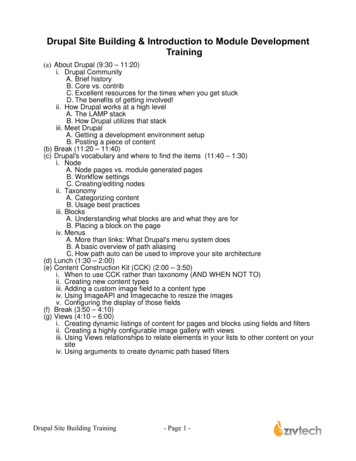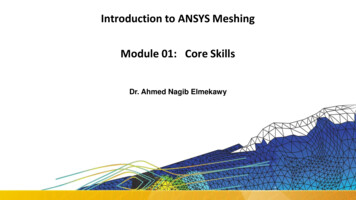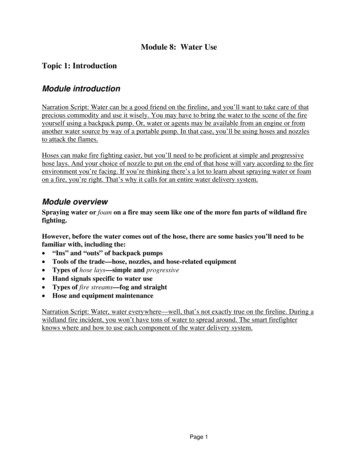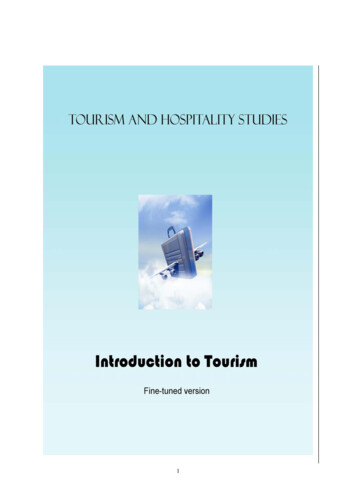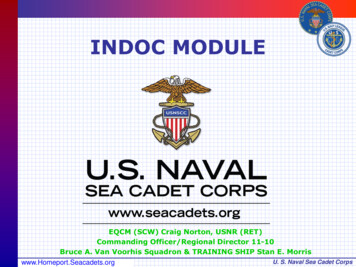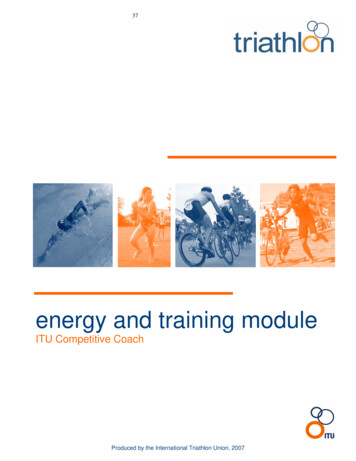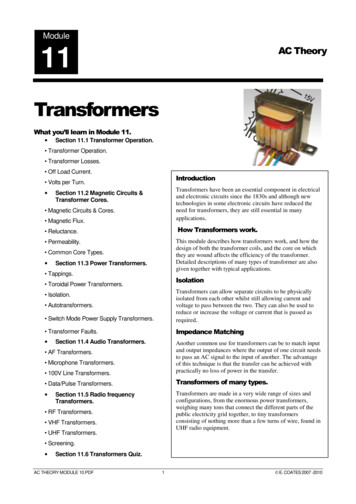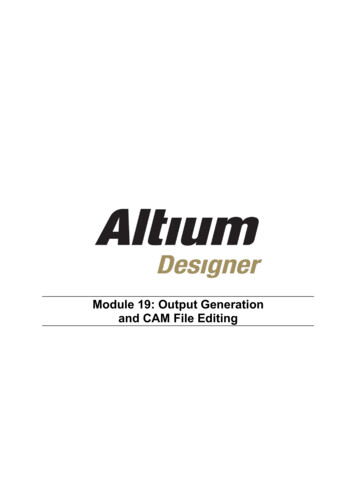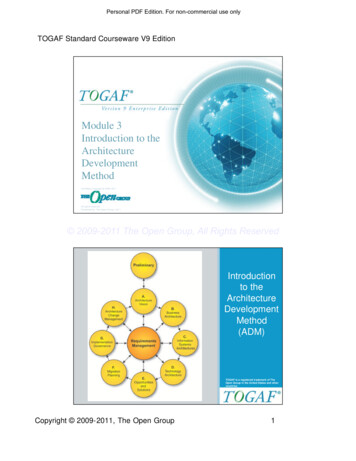
Transcription
Personal PDF Edition. For non-commercial use onlyTOGAF Standard Courseware V9 EditionModule 3Introduction to theArchitectureDevelopmentMethodV9 Edition Copyright 2009-2011Slide 1 of 19All rights reservedPublished by The Open Group, 2011 2009-2011 The Open Group, All Rights ReservedIntroductionto theArchitectureDevelopmentMethod(ADM)TOGAF is a registered trademark of TheOpen Group in the United States and othercountriesSlide 2 of 19Copyright 2009-2011, The Open Group1
Personal PDF Edition. For non-commercial use onlyTOGAF Standard Courseware V9 EditionModule ObjectivesThe objectives of this module are to describe: The TOGAF ADM Its relationship to other parts of TOGAF The phases of the ADM How and why to adapt the ADM How to scope an architecture activity The need for an integration frameworkSlide 3 of 19 2009-2011 The Open Group, All Rights ReservedWhat is the TOGAF ADM? The ADM forms the core of TOGAF The result of contributions from many architecture practitioners It is specifically designed to address enterprise’s business and ITneeds by providing:–A set of architecture views (business, data, application, technology)–Guidelines on tools for architecture development–A set of recommended deliverables–Links to practical case studies–A method for managing requirementsSlide 4 of 19Copyright 2009-2011, The Open Group2
Personal PDF Edition. For non-commercial use onlyTOGAF Standard Courseware V9 EditionArchitecture Development Method –Process The ADM is an iterativeprocess:– Over the whole process– Between phases– Within phases For each iteration, reconsider:– Scope– Detail– Schedules, milestonesSlide 5 of 19 2009-2011 The Open Group, All Rights ReservedArchitecture Development Method –Process Consider assets from:– Previous iterations– Marketplace, accordingto availability,competence, and value: Other frameworks Systems models Vertical Industry modelsSlide 6 of 19Copyright 2009-2011, The Open Group3
Personal PDF Edition. For non-commercial use onlyTOGAF Standard Courseware V9 EditionRelationship to other Parts of TOGAFThe ADM forms the core of TOGAFIt is supported by the other main parts of TOGAF:– ADM Guidelines and Techniques Set of guidelines, templates, checklists– Architecture Content Framework– The Enterprise Continuum Framework and context for architecture assets includingdescriptions, models and patterns– TOGAF Reference Models– The Architecture Capability FrameworkSlide 7 of 19 2009-2011 The Open Group, All Rights ReservedPrepare the organization for asuccessful architecture projectSet the scope, constraints andexpectations for a TOGAF project;create the Architecture Vision;validate the business context; createthe Statement of Architecture WorkADM PhasesProvide continual monitoring and achange management process toensure that the architectureresponds to the needs of theenterpriseProvide architectural oversightfor the implementation; ensurethat the implementationproject conforms to thearchitectureAnalyze costs, benefits andrisks; develop detailedImplementation andMigration PlanEnsure that very stage of aTOGAF project is based on andvalidates business requirementsSlide 8 of 19Copyright 2009-2011, The Open GroupDevelop BusinessArchitectureDevelop baseline and targetarchitectures andanalyze the gapsDevelop InformationSystems ArchitecturesDevelop baseline andtarget architectures andanalyze the gapsDevelop TechnologyArchitectureDevelop baseline and targetarchitectures andanalyze the gapsPerform initial implementationplanning; identify majorimplementation projects4
Personal PDF Edition. For non-commercial use onlyTOGAF Standard Courseware V9 EditionADM Phase Steps ExampleThe order of the stepsshould be adapted tothe situation.In particular you shoulddetermine whether it isappropriate to do theBaseline BusinessArchitecture or TargetBusiness Architecturedevelopment firstPhase B Steps9. Create ArchitectureDefinition Document8. Finalize the BusinessArchitecture7. Conduct formal stakeholder review6. Resolve impacts across theArchitecture Landscape5. Define roadmap components4. Perform gap analysis3. Develop Target Business Architecture Description2. Develop Baseline Business Architecture Description1. Select reference models, viewpoints, and toolsTMSlide 1 0 of 14Slide 9 of 19 2009-2011 The Open Group, All Rights ReservedADM Inputs and Outputs TOGAF defines a number of input and outputdeliverables for each phase– These are suggestions and need not be followed exactly– Output of an early phase may be modified in a later phase– Version numbers are used to manage the output– A convention is used to illustrate the evolution of deliverables 0.1 – a high level outline deliverable 1.0 – a formally reviewed detailed deliverableSlide 10 of 19Copyright 2009-2011, The Open Group5
Personal PDF Edition. For non-commercial use onlyTOGAF Standard Courseware V9 EditionAdapting the ADM Generic methodology intended for variable:– Geographies– Vertical sectors– Industry types Usable with deliverables of other frameworks suchas Zachman, DODAF, It is usual to modify or extend the ADM to suit specificneedsSlide 11 of 19 2009-2011 The Open Group, All Rights ReservedGoverning the ADM The ADM, whether adapted or used as is, is a key processto be managed and governed The Architecture Board should be satisfied that the methodis being applied correctly The management of all architectural artifacts, governanceand related process should be supported by a controlledenvironment such as a repositorySlide 12 of 19Copyright 2009-2011, The Open Group6
Personal PDF Edition. For non-commercial use onlyTOGAF Standard Courseware V9 EditionGovernance Repository Reference Data Process Status Audit InformationSlide 13 of 19 2009-2011 The Open Group, All Rights ReservedReasons to constrain the Scope ofArchitectural Activity The organizational authority of the team producing thearchitecture The objectives and stakeholder concerns to be addressedwithin the architecture The availability of people, finance, and other resourcesSlide 14 of 19Copyright 2009-2011, The Open Group7
Personal PDF Edition. For non-commercial use onlyTOGAF Standard Courseware V9 EditionScoping the Architecture Activity There are four dimensions in which scope may belimited:– Enterprise scope or focus– Architecture domains– Vertical scope (level of detail)– Time periods (Project Schedule)Slide 15 of 19 2009-2011 The Open Group, All Rights ReservedArchitecture Integration There is a need to provide an integration framework thatsits above individual architectures:– To allow the architect to understand how components fit into theframework– To derive the architectural models that focus on enterprise-levelcapabilities– To define the conformance standards that enable the integration ofcomponents for maximum leverage and re-use An “Enterprise framework” – a Content Framework, or aMeta-architecture frameworkSlide 16 of 19Copyright 2009-2011, The Open Group8
Personal PDF Edition. For non-commercial use onlyTOGAF Standard Courseware V9 EditionSummary The ADM is a comprehensive, general method It recommends a sequence for various phases and stepsinvolved in developing an architecture It is an iterative method It draws on the other parts of TOGAF for assets andprocesses It can be used with other deliverables from otherframeworksSlide 17 of 19 2009-2011 The Open Group, All Rights ReservedTest Yourself QuestionQ. The following statements describe the phases of the ADM,except ?A. They are cyclical.B. They are iterative.C. Each phase refines the scope.D. Each phase is mandatory.E. The phases cycle through a range of architecture views.Slide 18 of 19Copyright 2009-2011, The Open Group9
Personal PDF Edition. For non-commercial use onlyTOGAF Standard Courseware V9 EditionIntroductionto theArchitectureDevelopmentMethod(ADM)TOGAF is a registered trademark of TheOpen Group in the United States and othercountriesSlide 19 of 19 2009-2011 The Open Group, All Rights ReservedCopyright 2009-2011, The Open Group10
The TOGAF ADM Its relationship to other parts of TOGAF The phases of the ADM How and why to adapt the ADM How to scope an architecture activity The need for an integration framework Slide 4 of 19 What is the TOGAF ADM? The ADM forms the core of TOGAF The result of contributions from many architecture practitionersFile Size: 1MB

